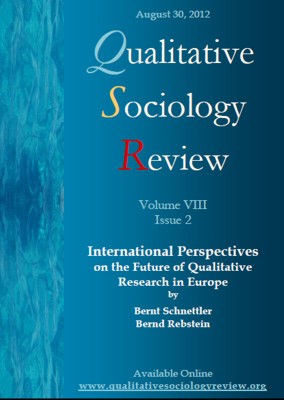Analyzing Emotional Styles in the Field of Christian Religion and the Relevance of New Types of Visualization
DOI:
https://doi.org/10.18778/1733-8077.8.2.07Keywords:
Religion, Religiosity, Emotion, Emotional Culture, Video Analysis, Feeling Rules, Emotional Regime, New Religious Movements, Church LifeAbstract
In the following text the theoretical conception, the employed analysis methods and some first results of the research project “The Emotionalization of Religion” are presented. The aim of the project is to compare newer Christian congregations with a Pentecostal or evangelical orientation to Christian parishes affiliated with the Evangelical Church in Germany or the Roman Catholic Church with regard to their respective emotional culture. The employed method set includes several qualitative methods, such as videoanalysis, the analysis of guideline interviews and participant observation. A particular focus lies within the empirical paragraph on the question: What role do new types of media usage in Christian parishes play for the development, representation and analysis of new emotional styles?
Downloads
References
Bell, Daniel. 1977. “The return of the sacred? The argument on the future of religion.” British Journal of Sociology 28:419-449.
Google Scholar
DOI: https://doi.org/10.2307/589420
Berger, Peter L., (ed.). 1999. “The Desecularization of the World.” Pp. 1‒18 in The Desecularization of the World: Resurgent Religion and World Politics. Washington: Eerdmans.
Google Scholar
Flusser, Vilém. 1995. Die Revolution der Bilder. Der Flusser-Reader zu Kommunikation, Medien und Design. Mannheim: Bollmann.
Google Scholar
Goffman, Erving. 1959. The Presentation of Self in Everyday Life. New York: Doubleday.
Google Scholar
Gordon, Steven L. 1990. “Social Structural Effects on Emotions.” Pp. 145-179 in Research Agendas in the Sociology of Emotions, edited by T. Kemper, D. Theodore. Albany: State University of New York Press.
Google Scholar
Harré, Rom, (ed.). 1986. “An Outline of the Social Constructionist Viewpoint.” Pp. 2-14 in The Social Construction of Emotions. Oxford: Basil Blackwell.
Google Scholar
Hochschild, Arlie. 1979. “Emotion Work, Feeling Rules, and Social Structure.” The American Journal of Sociology 85:551-575.
Google Scholar
DOI: https://doi.org/10.1086/227049
Hüwelmeier, Gertrud and Kristine Krause, (eds.). 2009. Traveling Spirits. Migrants, Markets and Mobilities. New York: Routledge.
Google Scholar
DOI: https://doi.org/10.4324/9780203865262
Kern, Thomas. 1998. Schwärmer, Träumer und Propheten. Frankfurt am Main: Knecht.
Google Scholar
Knoblauch, Hubert. 2005. “Video-Interaktions-Sequenzanalyse.” Pp. 263-275 in Ikonologie des Performativen, edited by C. Wulf, J. Zirfas. Munich: Wilhelm Fink Verlag.
Google Scholar
Knoblauch, Hubert, Bernt Schnettler and Jürgen Raab. 2009. “Video-Analysis. Methodological Aspects of Interpretive Audiovisual Analysis in Social Research.” Pp. 9-26 in Video Analysis: Methodology and Methods. Qualitative Audiovisual Data Analysis in Sociology, edited by H. Knoblauch, B. Schnettler, J. Raab et al. Frankfurt am Main: Peter Lang.
Google Scholar
Krämer, Sybille. 2003. “«Schriftbildlichkeit» oder: Über eine (fast) vergessene Dimension der Schrift.” Pp. 157-176 in Bild, Schrift, Zahl, edited by S. Krämer, H. Bredekamp. Munich: Wilhelm Fink.
Google Scholar
Langer, Susanne K. 1965. Philosophie auf neuem Wege. Das Symbol im Denken, im Ritus und in der Kunst. Frankfurt am Main: Fischer.
Google Scholar
Loseke, Donileen R. and Margarethe Kusenbach. 2007. “The Social Construction of Emotions.” Pp. 511-529 in Handbook of Constructionist Research, edited by J. A. Holstein and J. F. Gubrium. New York: The Guilford Press.
Google Scholar
Luckmann, Thomas. 1967. The Invisible Religion: The Problem of Religion in Modern Society. New York: Macmillan.
Google Scholar
Lutz, Catherine A. 1988. Unnatural Emotions: Everyday Sentiments on a Micronesian Atoll and Their Challenge to Western Theory. Chicago: University of Chicago Press.
Google Scholar
DOI: https://doi.org/10.7208/chicago/9780226219783.001.0001
Mayring, Philipp, Michaela Gläser-Zikuda and Sascha Ziegelbauer. 2005. “Auswertung von Videoaufnahmen mit Hilfe der Qualitativen Inhaltsanalyse – ein Beispiel aus der Unterrichtsforschung.” Medien Pädagogik 9:1-17. Retrieved July 29, 2012: http://www.ssoar.info/ssoar/files/2008/47/mayringetal_medienpaedagogik.pdf
Google Scholar
DOI: https://doi.org/10.21240/mpaed/09/2005.04.01.X
Mellor, Philip A. 2007. “Embodiment, Emotion and Religious Experience: Religion, Culture and the Charismatic Body.” Pp. 587-607 in The Sage Handbook of the Sociology of Religion, edited by J. A. Beckford and N. J. Demerath. London: Sage.
Google Scholar
DOI: https://doi.org/10.4135/9781848607965.n29
Meyer, Birgit. 2006. Religious Sensations. Why Media, Aesthetics and Power Matter in the Study of Contemporary Religion. Amsterdam: Faulteit der Sociale Wetenschappen, Vrije Universiteit Amsterdam.
Google Scholar
Mitchell, William J. T. 1986. Iconology: Image, Text, Ideology. Chicago: University of Chicago Press.
Google Scholar
DOI: https://doi.org/10.7208/chicago/9780226148052.001.0001
Pickstock, Catherine J. C. 2010. “Liturgy and the Senses.” South Atlantic Quarterly 109:719-739.
Google Scholar
DOI: https://doi.org/10.1215/00382876-2010-014
Rentsch, Thomas. 1987. “Der Augenblick des Schönen. Visio beatifica und Geschichte der ästhetischen Idee.” Pp. 329-353 in Poetische Autonomie? Zur Wechselwirkung von Dichtung und Philosophie in der Epoche Goethes und Hölderlins, edited by H. Bachmaier, T. Rentsch. Stuttgart: Klett-Cotta.
Google Scholar
Riis, Ole and Linda Woodhead. 2010. A Sociology of Religious Emotion. New York: Oxford University Press.
Google Scholar
DOI: https://doi.org/10.1093/acprof:oso/9780199567607.001.0001
Roberts, Robert C. 2008. “Emotions Research and Religious Experience.” Pp. 490-503 in Religion and Emotion, edited by J. Corrigan. Oxford: Oxford University Press.
Google Scholar
DOI: https://doi.org/10.1093/oxfordhb/9780195170214.003.0028
Scherer, Klaus R. and Tobias Brosch. 2009. “Culture-Specific Appraisal Biases Contribute to Emotion Dispositions.” European Journal of Personality 23:265-288.
Google Scholar
DOI: https://doi.org/10.1002/per.714
Schindler, Ines, Veronika Zink, Johannes Windrich et al. forthcoming. “Admiration and Adoration: Their Different Ways of Showing and Shaping Who We Are.”
Google Scholar
Schnettler, Bernt, Hubert Knoblauch and Frederik S. Pötzsch. 2007. “Die Powerpoint-Präsentation. Zur Performanz technisierter mündlicher Gattungen in der Wissensgesellschaft.” Pp. 9-34 in Powerpoint-Präsentationen. Neue Formen der gesellschaftlichen Kommunikation von Wissen, edited by B. Schnettler, H. Knoblauch. Konstanz: UVK.
Google Scholar
Turner, Jonathan H. and Jan E. Stets, (eds.). 2005. The Sociology of Emotions. Cambridge: Cambridge University Press.
Google Scholar
DOI: https://doi.org/10.1017/CBO9780511819612
Wiesing, Lambert. 2005. Artifizielle Präsenz. Studien zur Philosophie des Bildes. Frankfurt am Main: Suhrkamp.
Google Scholar
Downloads
Published
How to Cite
Issue
Section
License

This work is licensed under a Creative Commons Attribution-NonCommercial-NoDerivatives 4.0 International License.











